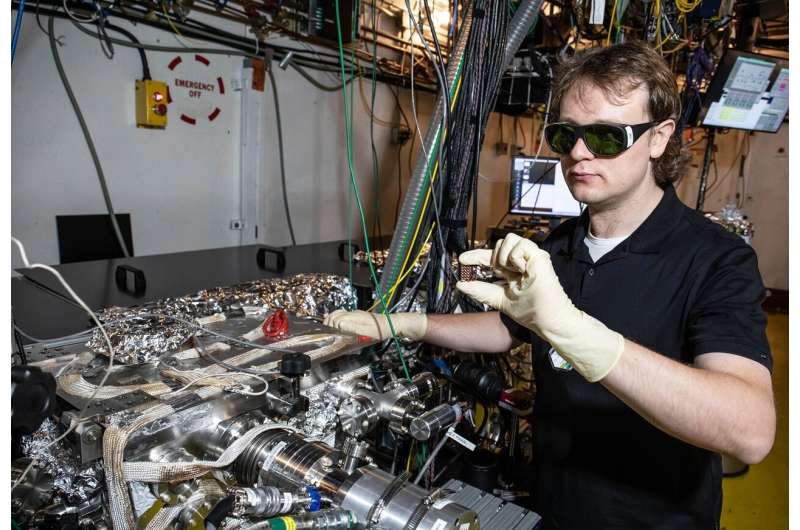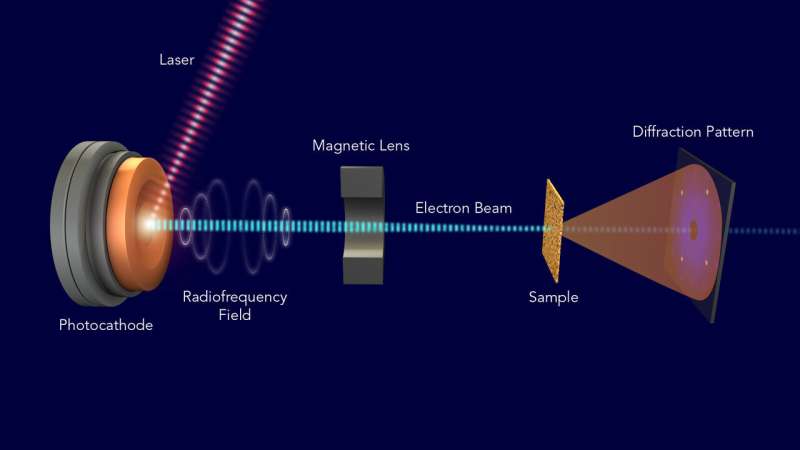SLAC staff scientist Alexander Reid, the first user of the lab's instrument for ultrafast electron diffraction (MeV-UED) since it became available to the international community as part of the LCLS facility, handles an interchangeable sample card used to hold samples during UED experiments. Credit: Jacqueline Orrell/SLAC National Accelerator Laboratory
Over the past few years, the Department of Energy's SLAC National Accelerator Laboratory has developed a new tool to visualize physical and chemical processes with outstanding clarity: an ultra-high-speed "electron camera" capable of tracking atomic motions in a broad range of materials in real time. Starting this week, the lab has made this tool available to researchers worldwide.
The tool is an instrument for ultrafast electron diffraction (MeV-UED). It uses a beam of highly energetic electrons to probe matter and is especially useful for understanding atomic processes occurring on timescales as short as about 100 femtoseconds, millionths of a billionth of a second. These rapid snapshots provide completely new insights into processes in nature and technology, benefitting applications in biology, chemistry, materials science and other fields.
The first proposal-driven experimental run of the MeV-UED instrument is scheduled through December this year and will deliver those powerful electron beams to 16 user groups from over 30 institutions. Experiments will initially focus on materials science and hot, dense states of matter.
MeV-UED complements the lab's suite of world-leading methods for studies of ultrafast science, including SLAC's flagship X-ray laser, the Linac Coherent Light Source (LCLS). Utilizing the whole breadth of these methods, scientists can explore very different, yet equally important aspects of speedy processes.
"In response to a DOE workshop on the future of electron scattering and diffraction in February 2014, SLAC launched an ultrafast electron diffraction initiative with the goal to develop a world-leading instrument whose capabilities would complement those of LCLS," says Xijie Wang, director of the MeV-UED instrument. "Making our cutting-edge technique available to the broad scientific community and supporting SLAC's program in ultrafast science is an exciting milestone for us."
The MeV-UED instrument has been incorporated into the LCLS user facility, adding to the experimental stations that use X-rays.
"The pace of progress in developing and applying this new tool for ultrafast science has been truly remarkable," says Mike Dunne, LCLS director. "We were delighted when the Department of Energy's Office of Basic Energy Sciences approved the incorporation of MeV-UED into LCLS, providing open access for researchers from across the US and around the world to this exciting new capability."
This animation explains how researchers use high-energy electrons at SLAC to study faster-than-ever motions of atoms and molecules relevant to important material properties and chemical processes. Credit: Greg Stewart/SLAC National Accelerator Laboratory
A catalyst for unmatched science
Wang and his team have been perfecting the technology since the program's start in 2014. Along the way, MeV-UED research has led to a considerable number of high-impact publications that describe discoveries in materials for solar cells and data storage; provided unprecedented movies of molecules vibrating and breaking apart; looked at the radiation damage in materials for nuclear fusion reactors; and uncovered exotic fluctuating material properties that could be used in molecular switches.
"Over the past four years, we have demonstrated that MeV-UED can lead to a paradigm shift in ultrafast electron diffraction, in part due to its versatility to probe a broad range of solid and gaseous samples," Wang says. "The high energy of the electrons, which is unique to our instrument, has transformed ultrafast electron diffraction from a qualitative science to a quantitative one, and our experiments are now employed to validate theoretical predictions and push new theoretical developments."
The team's latest R&D is devoted to exploring science in liquid states, the natural environment for many biochemical processes, so scientists will soon be able to home in even more on some of the most gripping details of biology and chemistry.
Joining forces to break new scientific ground
The new instrument's full potential becomes even clearer when combined with the lab's X-ray laser.
With LCLS, scientists can track molecular changes that occur extremely quickly—within just a few femtoseconds. With MeV-UED, they can unearth crisp images of molecules with unparalleled atomic resolution during these quick reactions. Both—extraordinary resolution in space and in time—help develop a complete picture of speedy fundamental processes.
This is exemplified by two studies of a chemical reaction, in which ring-shaped molecules break open in response to light—a process that plays an important role in the production of vitamin D in our bodies. A few years ago, researchers made a molecular movie using LCLS, which provided the very first glimpses into the workings of the reaction. A more recent study, using MeV-UED, added additional high-resolution details.
Schematic of SLAC’s new apparatus for ultrafast electron diffraction – one of the world’s fastest “electron cameras” – researchers can study motions in materials that take place in less than 100 quadrillionths of a second. A pulsed electron beam is created by shining laser pulses on a metal photocathode. The beam gets accelerated by a radiofrequency field and focused by a magnetic lens. Then it travels through a sample and scatters off the sample’s atomic nuclei and electrons, creating a diffraction image on a detector. Changes in these diffraction images over time are used to reconstruct ultrafast motions of the sample’s interior structure. Credit: Greg Stewart/SLAC National Accelerator Laboratory
"Together, LCLS and MeV-UED form a one-stop X-ray photon and electron factory with a symbiotic relationship, and they address the broad needs of our scientific community," says LCLS scientist Mike Minitti, who is in charge of integrating a proposal-based selection process for experiments at the MeV-UED instrument, similar to the X-ray facility's existing proposal review process.
Welcoming scientists from around the world
Over the past years, while Wang's team built their instrument from the ground up, some outside groups were invited to perform research projects with MeV-UED in collaboration with the SLAC team.
Now, SLAC has opened access to the instrument to virtually everyone. Researchers can submit proposals for experiments, which are then evaluated by a committee of experts, ranked and, if successful, given time to conduct the experiment. That's the same way LCLS and other X-ray light sources handle access to their instruments.
While users will come from around the globe during the coming months, the first experiment at the instrument is being done by a researcher who has been involved with MeV-UED since the beginning, designing sample chambers for solid materials. Alexander Reid, a staff scientist at LCLS and the Stanford Institute for Materials and Energy Sciences (SIMES), is collecting data this week.
"It is immensely gratifying to see the MeV-UED system, which started with a can-do attitude and lots of borrowed parts, become a real powerhouse for scientific discovery," Reid says.
Reid is looking at magnetic phenomena on the nanoscale in materials like iron-platinum, a novel but complex material that is relevant for cloud-based data memory and could improve the efficiency and reliability of data storage. But before the material can be widely used, researchers first need to understand its fundamental magnetic behavior.
"With LCLS, we can get a very good measurement of how magnetism changes on very fast timescales. With UED, we can look at the material's atomic structure and how it reacts to the changing magnetism," Reid says. "Putting these two measurements together provides the full picture of what the whole system is doing."
Provided by SLAC National Accelerator Laboratory

























